Actually, I don't really hate old Mercurys; I just do not
consider them to be likely candidates for "cheap power," which,
if you will re-read the very first column, is what I like
to discuss here.
Although Mercury began production under that name in 1939,
few pre-war Mercurys are seen, so what we are talking about
here is Mercurys from the '40s, 50's, and 60's.
Old Mercurys are very much loved by collectors of old outboard
motors, which is the first problem with them; the collectors
drive-up the prices of old Mercurys to a greater extent than
they do the prices of the more common OMC (Johnson, Evinrude,
and Gale) models, so a Mercury is likely to cost you more
in the first place. Another concern is the availability of
replacement parts and the cost of them. There are just fewer
new parts available for old Mercurys, and these parts are
generally more expensive than similar parts for the OMC engines.
This is due simply to the market forces of supply and demand;
there were more OMC engines than Mercurys sold in the 50's
and '60s, and there are more of the OMC's still out there
running.
It is not uncommon to see anglers using '50s OMC engines,
but one rarely sees a '50s Mercury on the water anymore, except
at antique outboard meets.
Another reason that I would advise "cheap-power" seekers to
avoid older Mercurys is that more special tools are required
to work on them. For example, an ordinary set of SAE wrenches
and some screwdrivers are all one needs in order to replace
the waterpump impellers in nearly all mid- to late '50s OMC's;
Mercurys from the same era, however, require a lot of special
tools, which are usually specific to only a few models or
a few model years. The 1955 20 cubic inch Mercury outboard
uses different special tools for the above mentioned job than
the 1959 20 cubic inch Mercury, for example.
In many respects, the old Mercs are just less "user-friendly"
than old OMC's. On Mercurys, one often finds left-hand threads,
fine threads, and other strange bits of engineering that seem
to exist only becuse Mercury wanted to do things differently
than other outboard manufactueres did. The ultimate example
of this is the strange transmisison arrangments of the late
'50s Mercurys. Rather than utilize the proven "dog clutch"
arangement like all other outboard manufacturers were using,
Mercury tried using an overly-complicated planetary transmisison
arrangment in their smaller engines, while the largest engines
utilized "direct reversing;" the engine was literally stopped
for "neutral" and re-started backwards for reverse. Neither
of these systems could be considered succesfull, and after
a few years, Mercury went back to the dog clutch.
Just as OMC produced outboards sold under "store names" (see
Gale
Warnings column), so did Mercury. From just after
World War II until the late '50s, Western Auto stores sold
"Wizard" outboards that were actually manufacturerd by Mercury.
The Wizards were almost never direct copies of current production
Mercurys, but instead were sometimes amalgamations of "left
over" and specially-manufactured parts.
Both Mercurys and the Western Auto Wizards enjoyed a reputation
for being "fast" outboards, but when it came to convenience
items such as remote fuel tanks and full gearshifts, the Mercurys
often had trouble conpeting against the OMC's. Atlhough Mercurys
won most of the racing events (and racing Mercurys are much
sought after by collectors) it was the easy-to-operate OMC's
that won the race to "move" outboards out the front doors
of dealerships.
To summurized what is going to be a very brief column, Mercurys
from the '50s and 60's are great engines for those with an
interest in engines, but if your interest is in cheap power
for your boat, I would suggest avoiding them.
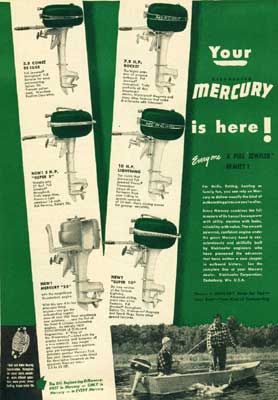
A 1948 advertisement for the entire Mercury line.
(click to enalrge)
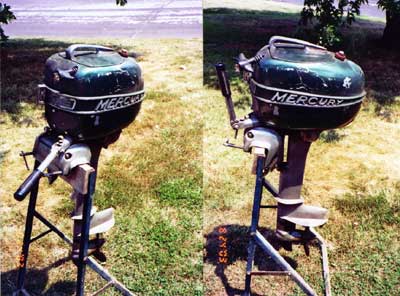
A 7.5 hp Mercury from about 1950; no neutral, no reverse,
and if the recoil starter breaks, no way to start the motor
(OMC's all had an emergency rope sheave where one could wrap
a rope around the flywheel to start)

The Mercury "Cruiser" was Mercury's first gearshift model,
from about 1952, and is an extremely rare and sought-after
engine.
(click to enlarge)
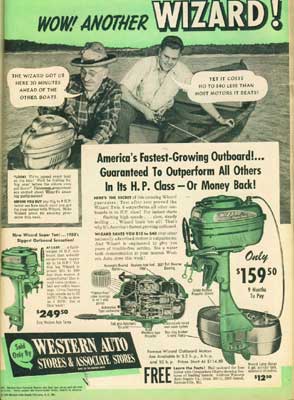
From the end of World War II until the late '50s, Mercury
made outboards which were sold by Western Auto stores under
the "Wizard " name. These were usually specially -built versions
and not just re-labled standard Mercury models. This advertisement
from 1950.
(click to enlarge)
 A 6 hp Western Auto wizard from about
1950.
A 6 hp Western Auto wizard from about
1950.

A 1954 Mercury Mark 20; about 16 hp, a full gearshift, and
used a presureized fuel tank that is virtually impossible
to find today.

A 1955 40 hp Mercury 4-cylinder in-line outboard.
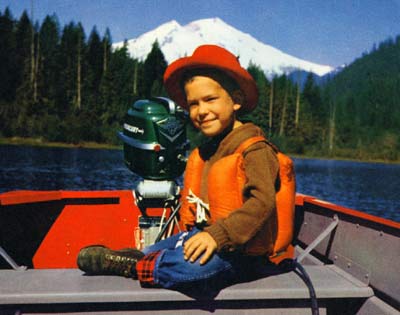
1955 5.9 hp Mercury outboard with "push-button" neutral and
180-degree steering for reverse. This photo is titled, "Portrait
of a Happy Boy."
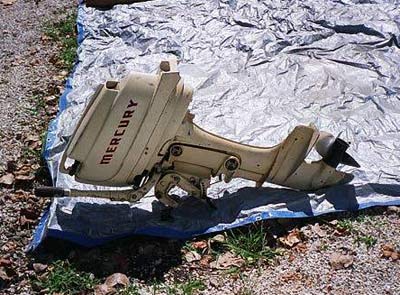
An "automatic" transmission Mercury from the late '50s; I
strongly suggest that you avoid any small late '50s / early
'60s Mercury that combines the shift and the throttle into
the tiller twist-grip, as these models are rather difficult
to do common repairs on. These are different than much newer
Mercs that also feature the shift and throttle in the twist-gripe.
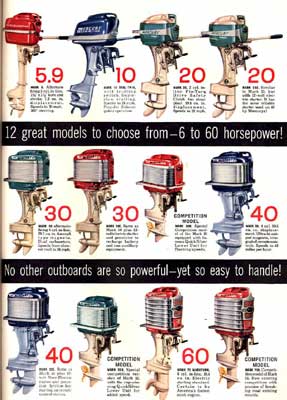
Mercurys did not become "Black" until 1962 through 1964; Late
'50s Mercurys, as this ad from 1957 shows, were a rather colorful
bunch. Unfortunately, mis-guided souls attempting to make
their old Mercs appear "newer" often spray-paint these models
black, a capital offense in my book.
(click to enlarge)
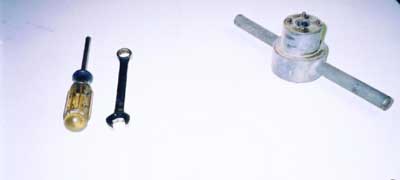
On the left, the "special tools" needed to change a water
pump impeller in virtually all OMC outboards made from 1955
until about 1968 (and later in some models). On the right,
the special tool needed to change the water pump impeller
in just one specific '50s Mercury model (other models need
other tools.)
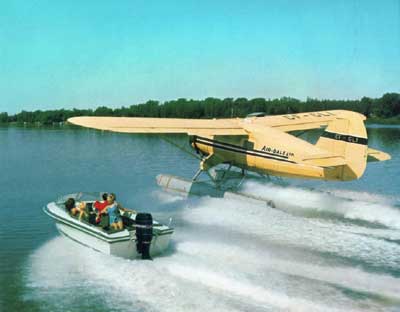
Mercury liked to promote their outboards as "faster" than
other brands (and often they were). A 1968 publicity photo.

The 20 hp Mercury of the late '60s and early '70s sold
well, but in the author's opinion it suffered from a weak
lower unit; the thin, streamlined housing was not too
"robust," and the propeller shaft was partially hollow and
had a large slot milled in it, due to Mercury's shifting
arrangment.
Later

